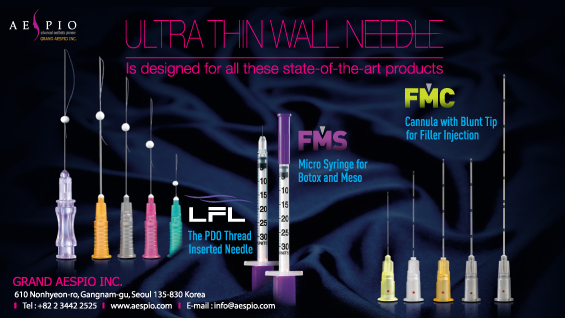Along with pigmentary disorders, vascular disorders are key areas of treatment in dermatology and can pose serious aesthetic problems. Doctors sometimes encounter pediatric patients with congenital vascular malformations. Adults are also affected by various vascular disorders and require appropriate treatment. In this series, Dr. Seung-pil Hong, Professor of Dermatology at Dankook University Hospital, will discuss the causes and clinical manifestations of different types of vascular disorders and introduce treatments with lasers including Pulsed Dye Laser(585, 595nm), Long Pulse Nd:YAG Laser, KTP Laser, and Diode Laser, etc.
The basic principle of tissue damage by laser is selective photothermolysis, which is also applied to treatment of vascular lesions. The purpose of treatment is not the destruction of hemoglobin which is a target chromophore for the laser's wavelength, but to ultimately destroy superficial capillaries containing red blood cells and hemoglobin. In theory, this treatment is carried out by using a laser with the thermal relaxation time (TRT) that is longer than that of normal capillaries while shorter than that of abnormal vascular lesions.
[Advertisement] ULTRA THIN WALL NEEDLE – Manufacturer: AESPIO(www.aespio.com)
Taking a closer look at the process of vessel destruction, laser beam is intensively and selectively absorbed by the hemoglobin in red blood cells circulating target vessels in the dermis and the heat energy is delivered to adjacent vessels. When the absorbed energy accumulates and the temperature of vessel walls reaches 70℃, the resulting thermocoagulation of proteins within vessel walls causes vascular contraction and leads to subsequent thrombosis and vascular obstruction. Vascular inflammation follows and certain blood vessels recover to it's normal state while those with severe damage and inflammation are permanently obstructed and destroyed.
For an effective vascular destruction, decision of appropriate wavelength and pulse duration is necessary. Moreover, as blood vessels exist not in the epidermis but in the dermis, the depth in which laser beam is able to reach should be considered. Considering these factors, lasers with various wavelengths and energy output and unique features are being produced and used for vascular treatment.
The most widely used lasers for vascular treament include 532nm KTP laser, 585nm or 595nm Pulsed Dye Laser(PDL), 755nm Long Pulsed Alexandrite laser, 810nm and 940nm Diode laser, and 1064nm Long Pulsed Nd:YAG Laser.
This article will cover basic principles of vascular treatment and Pulsed Dye Laser, one of the most common treatment modality of vascular lesions.
Selection of appropriate wavelength
Hemoglobin is a type of chromophore and can be divided into oxygenated and deoxygenated hemoglobin. Oxygenated hemoglobin is the major chromophore involved in hemangioma and port-wine stains. Oxygenated hemoglobin easily absorbs wavelengths of 418nm, 542nm, 577nm (with high absorption coefficient). The absorbed energy for hemoglobin can be lower with a laser of longer wavelengths than the mentioned wavelengths, however, longer wavelengths can still be used for vascular treatment as it can avoid melanin interference and can be absorbed by oxygenated hemoglobin lying deeper in the skin.
PDL has a wavelength close to 577nm and is ideal for vascular treatment as it reaches deeper than the 418nm laser and has a relatively lesser melanin interference. Also, the absorption peak of deoxygenated hemoglobin is around 430nm and 555nm wavelengths. The range of wavelength is slightly different from those used in oxygenated hemoglobin, however, therapeutic effect can still be achieved with the wavelengths of PDL.
Wavelengths of 940~980nm and 1064nm have low coefficients and therefore are not specific to hemoglobin. However, since its absorption to melanin is minimal, it can allow deeper penetration while minimally affecting surrounding tissues. Therefore, these wavelengths are ideal for treatment of thicker vessels lying deeper in the skin. One disadvantage is that it requires higher energy output due to relatively lower absorbed energy.
Wavelength is a key factor determining the absorbed dose of laser energy as well as the depth of skin penetration. Longer wavelengths allow for deeper penetration. Telangiectasia involving fine capillaries in the superficial facial skin can be reached by lasers of almost all above mentioned wavelengths. However, conspicuous venectasia of fine vessels of the lower limb lies at least 1~2mm deep and lasers with wavelength of at least 755nm or longer should be used. The absorption peak of oxygenated hemoglobin of such site is 418nm, which is not able to reach deep enough to bring clinical efficacy. A porcine skin study reported that the wavelength of 577nm is able to penetrate 0.5mm further into dermis from the epidermal basement membrane and 585nm can reach 1.2mm further. In a study on humans, the wavelength of 585nm for 0.45 msec with 5mm spot size was shown to reach the depth of 0.65mm. Moreover, laser of these parameters destroyed blood vessels of 150μm in diameter. On the other hand, vascular lasers with longer wavelengths are not readily absorbed into oxygenated hemoglobin. Therefore higher energy is needed to enhance the clinical effect, which raises the risk of thermal damage of the surrounding skin tissues and other side effects. However, as mentioned earlier, this type of laser may be more beneficial in patients with darker skin as it effectively avoids interference of melanin.
Selection of pulse duration
Thermal relaxation time (TRT) tends to be proportional to the square of vessel diameter (d). This can be expressed as; TRT of blood vessels (sec) ∝ d (mm²). Most lasers for vascular therapy is long pulsed and have TRT in the milli-second range which is much longer than that of Q-switching which has nano-second range due to its purpose of melanin destruction. Small vessels have shorter TRT requiring shorter pulse duration, whereas larger vessels require longer pulse duration.
A pulse duration corresponding to the TRT of target vessels should be selected to minimize damage to adjacent tissues and effectively destroy vascular lesions. Selection of this particular parameter may appear easy, however, determining the optimal pulse duration is often tricky due to the varying size of vascular lesions and diversity of vessel diameter within the lesion.
Shorter pulse duration entails higher risk of purpura, which is caused by destruction of fine capillaries in the superficial layer. Formation of purpura does not always indicate therapeutic effect, for purpura is more often caused by destruction of normal capillaries on the superficial skin and not the target vessels. Caution should be taken with longer pulse duration as it can overheat the target vessels and damage surrounding normal tissues.
-To be continued-
▶ Next Artlcle : #1-2. Pulsed Dye Laser Treatment





















